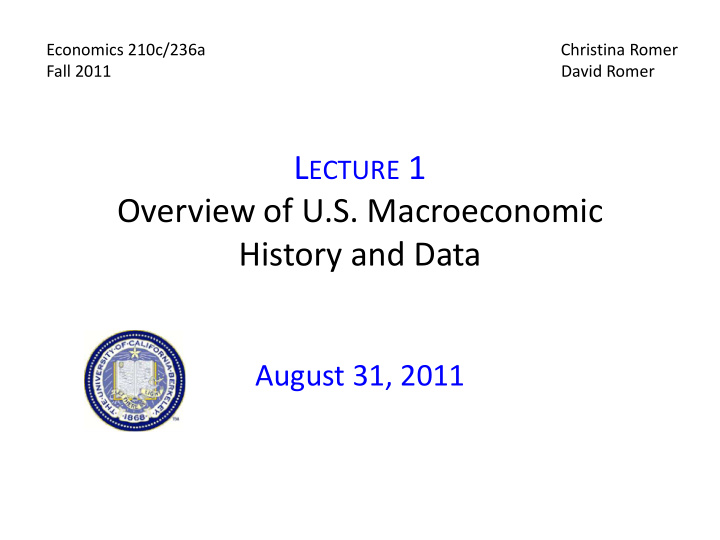



Economics 210c/236a Christina Romer Fall 2011 David Romer L ECTURE 1 Overview of U.S. Macroeconomic History and Data August 31, 2011
I. C HRISTINA R OMER : “S PURIOUS V OLATILITY IN H ISTORY U NEMPLOYMENT D ATA ”
Inconsistent Unemployment Data 30 25 20 Percent 15 10 5 0 1/1/1890 1/1/1898 1/1/1906 1/1/1914 1/1/1922 1/1/1930 1/1/1938 1/1/1946 1/1/1954 1/1/1962 1/1/1970 1/1/1978 1/1/1986 1/1/1994 1/1/2002 From Historical Statistics of the United States
Inconsistent Unemployment Data 14 12 10 8 Percent 6 4 2 0 1907 1915 1923 1931 1939 1947 1955 1963 1971 1979 1987 1995 2003 From Historical Statistics of the United States
Inconsistent GDP Data From Martin Neil Baily, “Stabilization Policy and Private Economic Behavior”
Lebergott’s Methodology Unemployed = Labor Force – Employed • Labor force is overestimated in recessions. • Employment is underestimated. • So unemployment is overestimated in recessions. • Just the opposite in booms.
More Consistent Unemployment Data From Christina Romer, ”Spurious Volatility in Historical Unemployment Data”
From Christina Romer, ”Spurious Volatility in Historical Unemployment Data”
Evaluation of Romer
Implications of Findings • Depression stands out more. • Why wasn’t there a stabilization?
II. J OSEPH D AVIS : “A N A NNUAL I NDEX OF U.S. I NDUSTRIAL P RODUCTION , 1790-1915”
Data Sources for Davis’s Index of Industrial Production
Evaluation of Davis
From Joseph Davis, “An Annual Index of Industrial Production, 1790-1915”
Davis Index of Industrial Production 8 7 6 5 4 Logarithms 3 2 1 0 1790 1798 1806 1814 1822 1830 1838 1846 1854 1862 1870 1878 1886 1894 1902 1910 From Joseph Davis, “An Annual Index of Industrial Production, 1790-1915”
From Joseph Davis, “An Annual Index of Industrial Production, 1790-1915”
Percentage Change in Industrial Production 0.2 0.15 0.1 0.05 0 -0.05 -0.1 -0.15 -0.2 -0.25 1791 1796 1801 1806 1811 1816 1821 1826 1831 1836 1841 1846 1851 1856 1861 1866 1871 1876 1881 1886 1891 1896 1901 1906 1911 From Joseph Davis, “An Annual Index of Industrial Production, 1790-1915”
Percentage Change in Industrial Production 0.20 0.15 0.10 0.05 0.00 -0.05 -0.10 -0.15 -0.20 1820 1825 1830 1835 1840 1845 1850 1855 1860 1865 1870 1875 1880 1885 1890 1895 1900 1905 1910 1915 Standard Deviation 1820-1889 0.060 1890-1915 0.089
From Joseph Davis, “An Annual Index of Industrial Production, 1790-1915”
Implications of Findings • May affect view of impact of panics in the 19 th c. • Increasing frequency of cycles after 1890 may reflect changes in price flexibility. • Changes in volatility may reflect the emergence of demand-driven recessions.
III. M ARGARET M C C ONNELL AND G ABRIEL P EREZ - Q UIROS , “O UTPUT F LUCTUATIONS IN THE U NITED S TATES : W HAT H AS C HANGED S INCE THE E ARLY 1980’ S ?”
From McConnell and Perez-Quiros, “Output Fluctuations in the United States”
From Christina Romer, ”Changes in Business Cycles”
From James Stock and Mark Watson, “Has the Business Cycle Changed?”
From McConnell and Perez-Quiros, “Output Fluctuations in the United States”
Has the Great Moderation Ended? 1953:Q2-1983:Q4 1984:Q1-1999:Q2 1984:Q1-2011:Q2 S.d. of quarterly GDP growth 1.14 0.53 0.65 (percentage points) S.d. of unemployment rate 1.70 1.00 1.46 (percentage points)
IV. C HRISTOPHER H ANES , “T HE D EVELOPMENT OF N OMINAL W AGE R IGIDITY IN THE L ATE 19 TH C ENTURY ”
From J. Bradford DeLong, “America’s Peacetime Inflation,” in Romer and Romer, eds., Reducing Inflation: Motivation and Strategy (1997)
Percent -6 -4 -2 0 2 4 6 8 1/1/1866 1/1/1869 Hanes's Wage Inflation Series 1/1/1872 1/1/1875 1/1/1878 1/1/1881 1/1/1884 1/1/1887 1/1/1890 1/1/1893 1/1/1896 1/1/1899 1/1/1902 1/1/1905
From Hanes, “The Development of Nominal Wage Rigidity in the Late 19 th Century”
From Hanes, “The Development of Nominal Wage Rigidity in the Late 19 th Century”
Recommend
More recommend